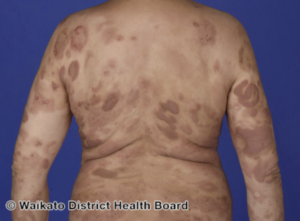Cutaneous T-Cell Lymphoma
CTCL is a type of non-Hodgkin’s lymphoma. It is a group of lymphoproliferative disorders characterized by the localization of neoplastic T cells to the skin. CTCL tends to affect older individuals with a mean onset at 50 to 60 years of age. It primarily affects males with a male-to-female ratio of 2:1. The two main subtypes of CTCL are Mycosis Fungoides (MF) and Sézary Syndrome (SS). MF is the most common subtype of CTCL, and it is mainly localized to the skin with an indolent course. SS is the second most common subtype that follows a more aggressive course where neoplastic T cells are found in the skin and bloodstream.
CTCL arises due to the malignant transformation of epidermal T-cells. The exact underlying pathophysiologic mechanism is not fully established. It has been linked to multiple factors, including viral infections (HTLV-1, EBV), medications (hydrochlorothiazide), immunosuppression (HIV, organ transplantation), environmental factors (exposure to chemicals, ionizing radiation or UV rays), and certain HLA subtypes.
CTCL can present in various ways that can progress depending on the stage of the disease. The lesions range from patches, plaques, tumors, or erythroderma. Lymph nodes and internal organs may be involved as well.
Diagnosis of CTCL is based on a combination of clinical, histological, immunophenotypical, radiological, and genetic data. Appropriate clinical staging should be carried out to determine the extent of the disease and the appropriate therapeutic option.
There is no current cure for CTCL. Management is aimed at reducing tumor burden, delaying progression, and preserving the quality of life. Current approaches are based on the underlying type and stage of the disease. Available options include:
- Topical treatment (steroids, nitrogen mustard, bexarotene).
- Phototherapy (UVB, NBUVB, UVA, PUVA).
- Radiation (localized, external beam).
- Systemic treatment (Retinoids, immunotherapy, biologics, histone deacetylate inhibitors, chemotherapy, allogeneic stem cell transplantation).
Written By: Dr. Jumana Aldhalaan, dermatology resident
Reference:
https://dermnetnz.org

